|
| |
KLUNG KLUNG TOUR - BALI - INDONESIA |
 |
Klunklung Tour
Sept 26
After a taxi ride to Serangan Island we boarded one of the four buses and headed out of town behind our police escort bound for the regency of Klungklung. Klungklung is considered to be the icon in spiritualism with an abundance of local artisans who produce quality handicrafts. |
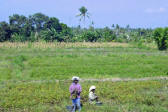
| |
 | 
| 
| 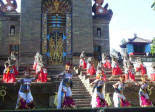
| 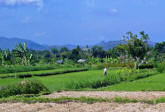
| |
Our first stop was Gunarsa Museum. We were seated in front of a temple like structure with Buddha's perched on the terraced slopes. The owner of the Art Museum painted a portrait of one of the cruisers and then we were entertained by several groups of Balinese dancers who performed the classical and graceful “Legong Dance,” accompanied by an all women band.
The Legong is a dance that was traditionally performed as entertainment for the king. The young females are wrapped from head to ankle in hand painted gold brocade, with glitter gold and sparkling mirrors topped with frangipani flowers. Their dance pantomimes ancient stories and portrays all that is feminine and beautiful. |
workers in the flat rice fields. |
Then we explored the beautiful grounds and the museum, built in modern Balinese architecture. We wondered around the three story gallery of artwork, modern and classical, and viewed other items on display.
|
 |  | 
|  | 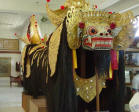 |
We enjoyed coffee and a snack at Gunarsa Museum before heading back on the bus to drive to our next destination.
|
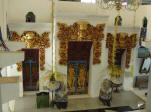
|
The exhibits included 2 huge black barongs (the evil one). |
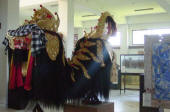 |
|
At Kamasan Village we witnessed the process of making handicrafts used not only for souvenirs and house hold ornaments but for ritual and ceremonial use in their traditional culture. |
 | 
| 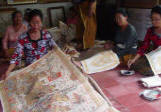
| 
| |
Hand painting bowls |
Pounding bark to make paper |
Hand painting the pounded parchment |
Silversmiths pounded bullet casings into fine works of art. |
There were many areas in the village with displays and at the end of one of the streets, we stumbled upon a little school. As soon as the kids saw us they scrambled to their seats to look studious and the boy's school band began to play for us.
| 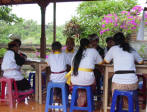 | 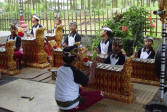 |  | 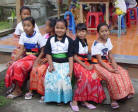 |
Back on the bus we continued down a rural road, past villages, people walking the roads with produce and even pigs slung on their shoulders. The women standing in the irrigation canal washing their clothes were laughing and shy about the fact that just about everyone on the bus took their picture!
|
 |  |
At ever stop, the military, police, army and security guards were abundant to protect their tourists! |
We visited a factory where traditional Balinese coins were made. After stamping out the coin in a
mould, they used a kiln to fire the artefact. Then the coins were polished and a hole punched out. |
 |  |  | 
|  |  |
It was an assembly line factory style production.
|
The traditional style coins are used in ceremonies and for decoration
making accessories. |
Shirt?...
Everywhere we walked hawkers followed us intently insistent that we buy from them. They would call out the price and if you ignored them the price would get lower and lower. Since I had forgotten to bring a sarong for supper that evening, I surrendered to one cute girl with beautiful gold Balinese style fabric. I only paid 2500 rupiah but she was convinced I needed another one of different color so she adhered to me with every step I took, even throwing the cloth onto my lap thru the door once I was seated on the bus! It became quite comical and we were all laughing at her persistence. |
 |
Our next stop was at Goa Lawah where ritual ceremonies are carried out daily in the Goa Lawah Temple. From the “Bat Cave” here, 7 million bats emerge each evening. Since the spilling of blood is not allowed in the temple, the bats are protected and are considered sacred because they live in the temple. The cave is considered holy with temples and shrines protecting the entrance. |
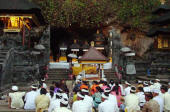 |  |
We arrived at Kerta Gosa, the King’s Palace and Hall of Justice after dark, which was a shame because the grounds were fabulous with gardens, lotus ponds and complex carved statues. It would have been great to see them in the daylight.
The palace was built in the 17th century and functioned as the royal assembly of Kings in Bali. It now serves as a religious and traditional court. We were told that we would have the first dinner ever served on the grounds since 1908 when the Klungklung kingdom was subdued by the Klungklung Battle with the Dutch. |
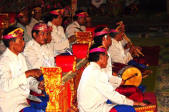 | Mask Dance
We were assembled in a grassy courtyard in chairs where we were entertained by yet another form of dancing, the Topang or Mask Dance. During the performances we were entertained by a percussion band and ate a very spicy traditional Balinese meal from a huge buffet spread out for us.
|
 |  |
After dinner we were treated to a full performance of the Barong Dance.
The barong is a strange creature created by two men inside a highly decorated framework that represents a stylized animal, often a kind of Chinese tiger. |
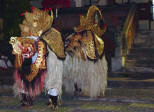 |  |
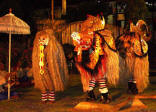 | 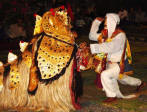 | 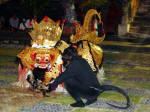 | |
 |
This is a multiple act dance representing good against evil and uses various animals (monkey) and characters wearing costumes and masks to depict the spirits that challenge the Barong.
|
The endless metaphysical battle between good and devil ends in the restoration of balance between forces |
Ceremonies over, on our way through the Palace grounds I heard a familiar voice and looked around to see the little girl still holding up the piece of fabric that she was so desperately trying to sell me at the last location. How she remembered me, (what I bought and how much I paid!), found me in the dark was beyond belief! But I still didn’t buy the sarong.
On our way back to the bus we stopped to watch another dance group at the temple that we thought were telling the story of the Royal Family. Some of the costumes looked like they depicted the Dutch soldiers with their white uniforms and guns. This form of dance called
Baris is a dance of war. Strongly masculine, it is a sacred dance usually performed at temple ceremonies. The dancers wore elaborate head dresses and carried spiked shields and swords. They danced aggressively in simulated battle. |
|
